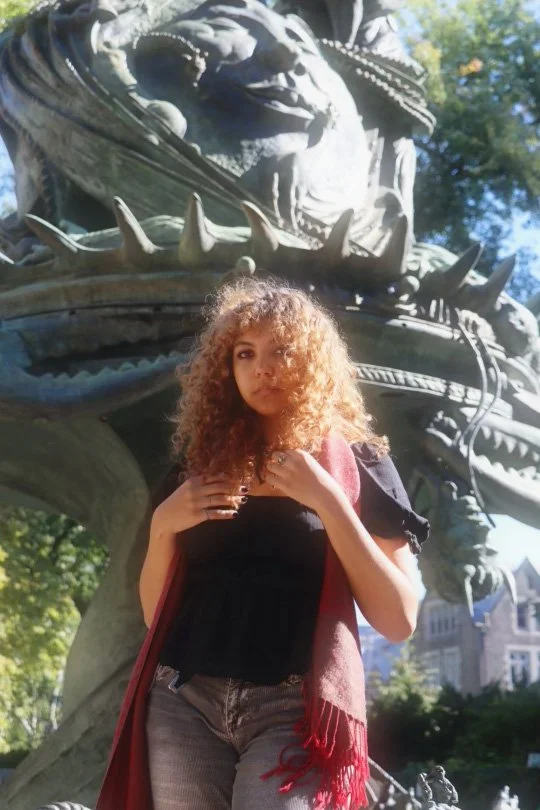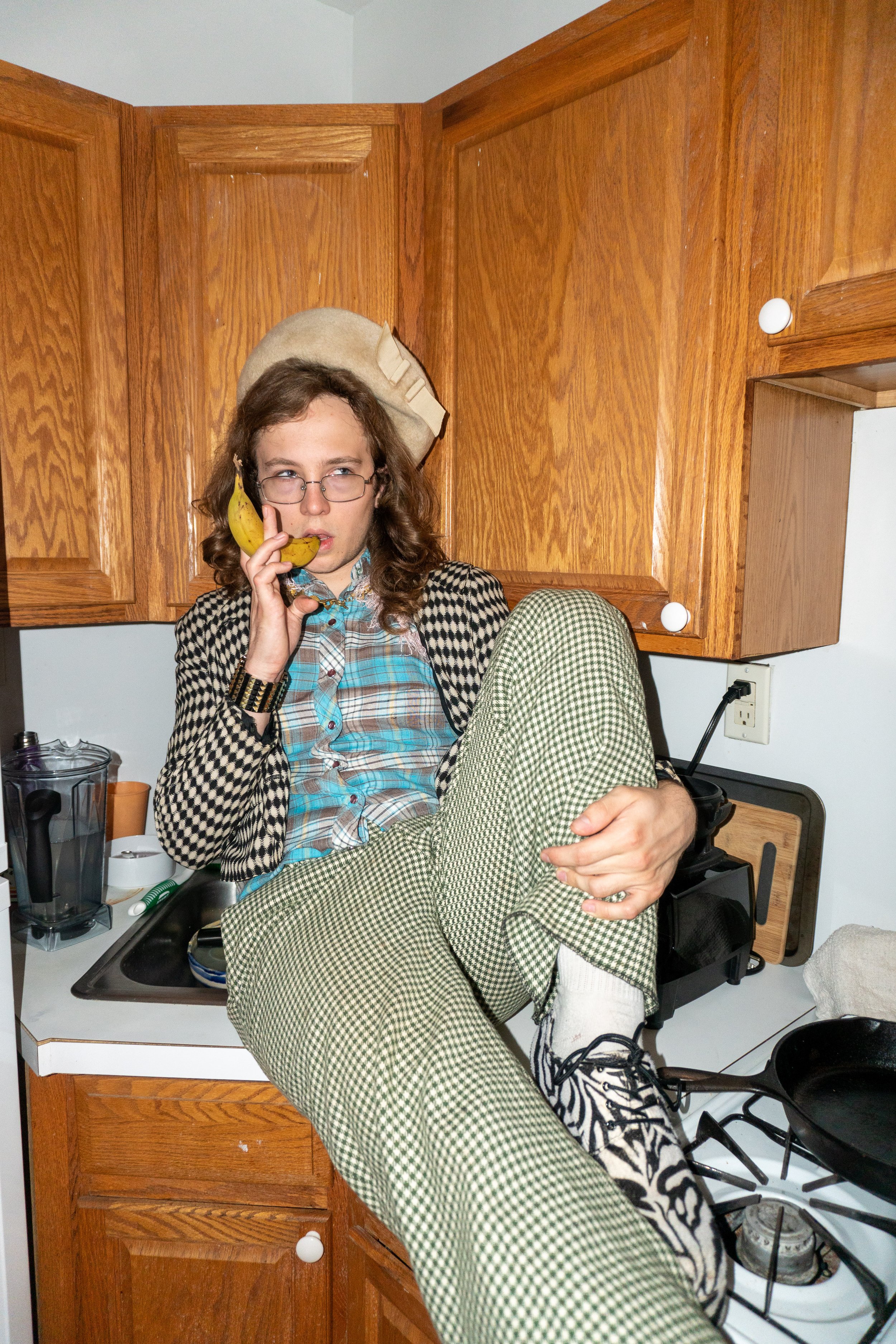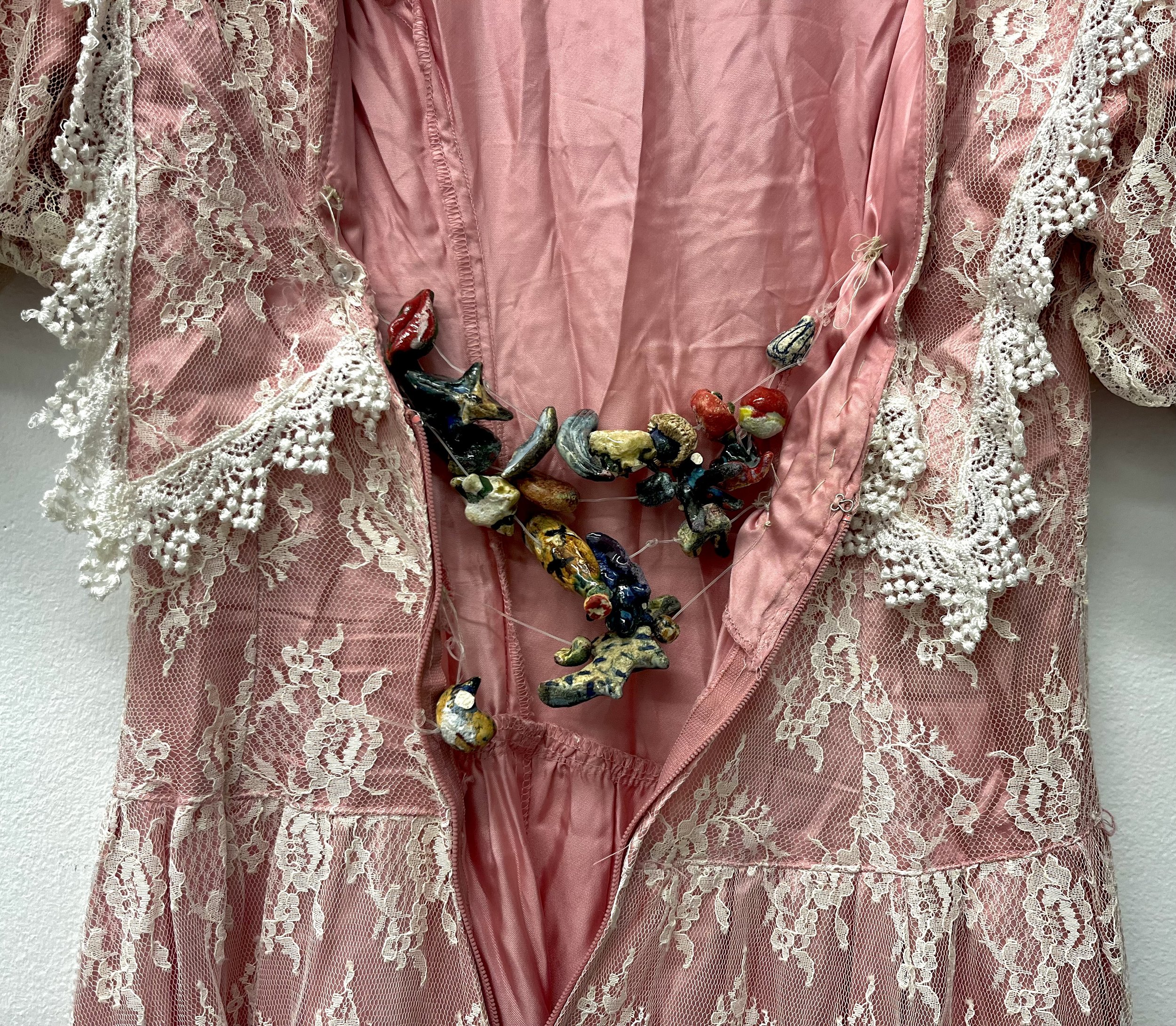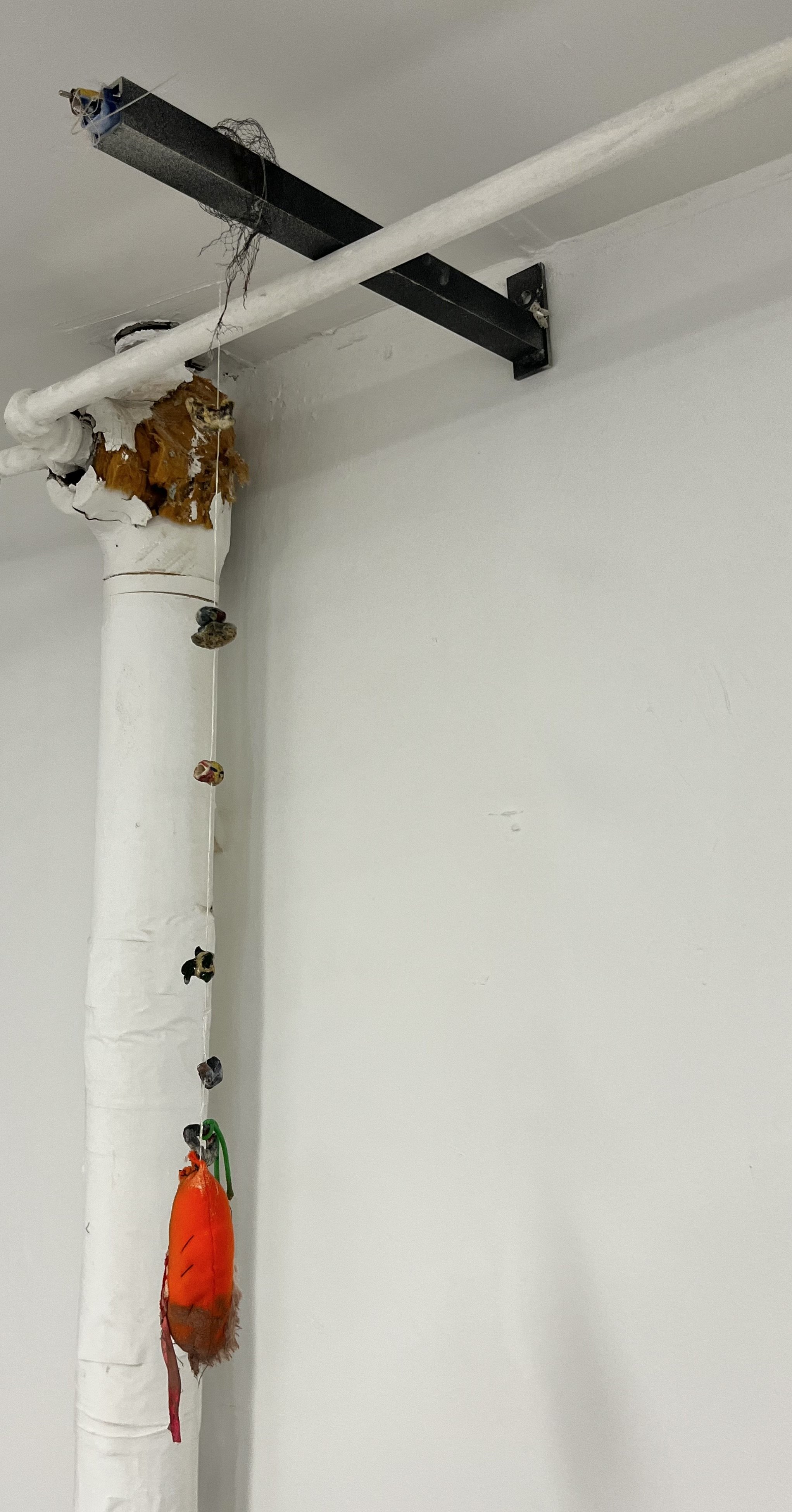Feature by Phoebe Klebahn
Photos by Mori Liu, assisted by Grace Schleck and Emily Chmiel
Hart Hallos is a senior in Columbia College studying Visual Arts. Hart’s artistic practice centers around exploring themes such as queerness, humor, power, delusion, trashiness, filth, and the language of emails. When asked to describe their artistic practice, Hart compares their relationship with art to joyfully chasing a butterfly through a field… and then tripping in a hole and breaking their ankle.
When I arrived at Hart's home I was greeted warmly. They invited me to sit down at the table in the quaint tableau of an Italian restaurant that Hart and their roommate had constructed against one of their living room walls. Hart struck me immediately as warm, welcoming, witty and carefree, and I was fascinated by the spacious, artistic, and intentional feel of their standard Columbia studio double. On the walls of the living room is an eclectic display of Hart’s art, as well as trinkets, baubles, pieces of quilt, and one of Hart’s old halloween costumes.
After properly admiring the walls and decorations, we talked for almost an hour about Hart’s life, academic and artistic journey, and their plans as a soon-to-be graduate.
Hart recently returned from a semester off, and told me a bit about how their time away from Columbia has influenced their ideal post graduate life.
“I do not think that when I get out of school making art will pay my bills, and that is fine by me. I took a semester off—which is why I have this shifted schedule and will be graduating in December—and I just worked at an ice cream store and paid my bills. And then this summer I worked at a food truck and paid my bills that way. And that's the current plan—to go back and do that and try to make art on my own time. I definitely do not have an expectation that art will support me at this point in time.”
Hart was born and raised in Lexington, Kentucky and they are absolutely thrilled to be moving back home this Spring.
“I feel like Kentucky is a way easier place for me to make stuff than New York is, which is something that took me a bit to realize. I find Lexington and the people I meet there very inspiring. The older artists in my life, who have somehow finagled their way into being supported financially by what they do, have told me to find the place first and then let the art follow from there.”
The presentation of queerness is an integral part of Hart’s artistic expression. Hart acknowledged that outsiders often perceive their love of their Southern hometown as being at odds with their queerness – but Hart doesn’t see it that way.
“So many of my social interactions freshman year were me, presenting as a very visible queer person, being like, ‘I'm from Kentucky.’ And people being like, ‘oh no!’ And for the first bit of college, I would be like, ‘Yeah, haha, it kind of sucks.’ But now I really try to be like, ‘Actually, Kentucky's awesome!’ I try to counter people's expectations, because people have that reaction a lot. But there are queer people in Kentucky. I promise. Everywhere! I'm interested in the lives of queer people in Kentucky. That is currently what a lot of my work is based around, so where better to do that than to be a queer person in Kentucky?”
The ceramic wall fountain Hart submitted as a part of their portfolio specifically speaks to these experiences. Last semester, many states, including Kentucky, explicitly banned gender affirming care for minors. Though the veto was overridden, this debate surrounding gender and gender affirming care caused Hart to examine and reflect on how gender and sexuality are publicly portrayed and commodified.
“I was just so viscerally upset by that and the idea of this place where all these really marginalized, vulnerable queer people exist being something that is able to be commodified and in such a direct way. I was just thinking about places that I'm familiar with, where queer people are still in those marginalized realms and where they still are trying to figure out ways to define themselves in opposition to how they're defined by institutions.”
Another moment Hart specifically mentioned as being integral to their artistic reflection on gender and queerness was when they discovered that Grindr had gone public on the New York Stock exchange.
“So for the ceramic piece, I was just thinking about all those things, and I was like, “I really want to make a piece about what it's like to be a gender non conforming individual from Kentucky'', and the existences of trans people in the South. And specifically trans people who aren't ready to be displayed at the New York Stock Exchange as an example of a perfectly ‘moral’ and ‘consumable’ and ‘flawless’ trans person who could run for president—like people who have all these bad behaviors and that are self destructive or unkind or whatever. To me that's a much more productive form of representation. And so that's what that piece was about. All those faces were based on different kinds of characters that I had imagined of Trans people who would be the last people to ever be on the face of a Capital One campaign. My ceramics professor was using the term ‘Grumsy’' at the time to describe ceramics—like how some things are just kind of gritty and they're not formed very perfectly or gracefully—and I was taking that term and applying it to identities and, I was like, ‘where are the grumsy queer people and how can I showcase their stories?’ Cause that's what I feel like I am.”
The ceramic piece was presented along with a performative element. Despite Hart's identification as a performance artist, they do not create art with the performance in mind.“I need an artistic idea, and then it's just like, ‘ell, it has to be performed, I guess.’” Hart views the performance process as challenging, stating that they “have to go lay down in a dark room” after, so they do not have an interest in making performance their main medium.
Hart spoke passionately about the influence that living in New York has had on their artistic process and development. Living in New York has made them want to run away from the city many times, and Hart constantly questions how much influence the city has on them versus the Columbia environment.
“I find it [being in the city] can be very distracting at the same time as it's very exciting because there's so much activity and there's so many things you find yourself wanting to do. I just find myself feeling very lost and confused a lot of the time here, and not feeling like I have the time to think or get closer to myself, like I can do in Kentucky. It's a time thing. It's like a space thing.”
“I surround myself with people who have similar qualms with the lifestyle of the city, and I try to use my work to be honest and call attention to this struggle..”
At Columbia, Hart works hard to cultivate comfortable physical and emotional spaces. Recently, they’ve been decorating their room, as well as their studio, noting their desire to “transform” the space into something unrecognizable as a standardized unit of Columbia property. Their walls are covered in fake brick wall paper, prints, sewing patterns, hanging objects and items of clothing. Every surface is filled with salvaged trinkets, that would put the most seasoned flea market goers in a state of awe.
After attending an arts magnet highschool, Hart felt burnt out coming into college. They hadn’t expected to get involved in Columbia’s art scene, but after they took their first studio drawings class they changed their mind. Hart joked that when they started down the visual arts path they felt pressure to complete both a visual arts and art history double major “in a desperate preprofessional move,” adding that once they began to work through their major classes, their longtime love of art \ became stressful and complicated.
“I think some of my most positive experiences taking art classes were the very first ones I took when I didn’t know if it was something I was going to necessarily major in, but that I did because it felt really good. Once you commit to the major, you're like, I should probably do a good job at the thing that I major in at the very least. And that, for me, added a ton of pressure and was part of the reason why I took time off between my junior and senior years, because I had to figure out a way to not have that all. I was basically only able to make stuff in sort of manic spurts. I look back at the work that I made during that time, and some of it I still feel a connection to, but I'm not sure who I was when I made some of it and I now know that I needed to figure out a way to be able to be thoughtful and spend time on my art without it being a torturous experience. There's definitely something at Columbia where it's like, if you're going to choose to do something, you must be exceptional at it.”
“It's an assertion of confidence to even be like, I major in this, and I feel good enough at this to make this the main thing I do in college, but then you're also supposed to be so good at it that you're able to immediately get a job in a field where there are truly no jobs for people graduating college, except for doing spreadsheets at a gallery, which is the very last thing I want to do.”
In terms of how they combat these pressures, Hart discussed focusing on “being a true beginner in something. I really like taking classes in stuff that I don't have experience in. There's something very comforting to me about being in that stage and not having some of the expectations that I really easily put on myself thrown at me just yet.”
As a second semester senior, Hart is beginning to plan their thesis project, and mentioned that they want to use the project to examine the concept of delusional confidence and what drives them to create art.
“The idea I have is a series of talking sculptures. They would do speeches about what's the best bathroom in the Watson studio building to have sex in with a stranger. Or I have an idea for a speech that's like, “Why I should never be marked late to class” that's about the fact that I have to figure out what my gender identity is every time I get ready in the morning and that’s hard, and so I should never be marked tardy ever. I want to do things that are intentionally ridiculous, but also honest. There are definitely aspects of existing that are absolutely fucking ridiculous, and I think I am really attracted to that delusion– people who have this sense of unshakeable purpose and confidence in themselves and what they do, because I don't have that whatsoever and so I'm fascinated by it.”
Who Loves The Sun?
“So I do want that feeling of confidence while also recognizing that it's delusional. I think creating stuff is a very nice place for me to explore a side of myself that I feel is typically very contained. I've been trying to figure out why I would ever make anything—what gives me the right to think that I should make anything when there's already 30,000 objects here? What gives me the right to add one more to the pile of objects that exist in the world? But I also think that's a question that, if you're thinking of it all the time, you'll never make anything, and when I don't make anything I'm really sad. You have to have some delusion about the necessariness of what you're doing to do anything at all, so why not embrace that sense of delusion?”
For more information about Hart and their work, follow them on Instagram at @_horse_friend25_.










































